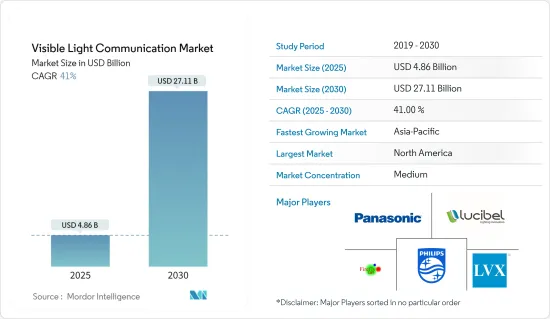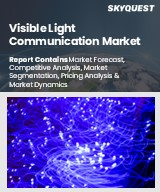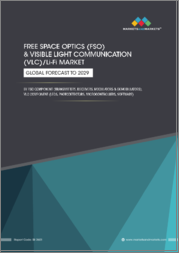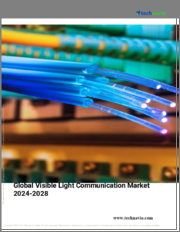
|
시장보고서
상품코드
1626900
가시광통신 : 시장 점유율 분석, 산업 동향 및 통계, 성장 예측(2025-2030년)Visible Light Communication - Market Share Analysis, Industry Trends & Statistics, Growth Forecasts (2025 - 2030) |
||||||
가시광통신 시장 규모는 2025년 48억 6,000만 달러로 추정되며, 예측 기간(2025-2030년) 동안 41%의 연평균 복합 성장률(CAGR)로 2030년에는 271억 1,000만 달러에 달할 것으로 예상됩니다.

고속 데이터 전송의 필요성, 데이터 보안, 임박한 RF 스펙트럼 제약, Wi-Fi 기술에 대한 다양한 기술적 우위가 주로 가시 광선 통신 시장을 주도하고 있으며, Li-Fi는 비용 효율적 일뿐만 아니라 약 100 배 빠른 데이터 전송 속도, 높은 데이터 보안, 전자기 간섭 없음, 저전력 등 현재 Wi-Fi 기술보다 다양한 이점을 가지고 있습니다. 높은 데이터 보안, 전자기 간섭 없음, 낮은 전력 소비 등 현재 Wi-Fi 기술보다 다양한 장점을 가지고 있습니다.
주요 하이라이트
- 그러나 제한된 통신 범위로 인해 Li-Fi의 적용에는 한계가 있는데, Li-Fi는 폐쇄 된 제어 환경에서 가장 잘 작동하고 다른 광원이 존재하면 성능이 저하되기 때문입니다. 그럼에도 불구하고, 이 부문에 대한 실질적인 조사는 향후 라이트 피델리티(Li-Fi) 시장 수요를 촉진할 것으로 예상됩니다.
- VLC는 Wi-Fi, Bluetooth, Zigbee와 같은 다른 무선 기술이 간섭을 받을 수 있는 환경에서도 안정적이고 안전한 통신을 가능하게 하기 때문에 사물인터넷(IoT) 기기에 특히 유용합니다. 또한, VLC는 빛이 벽을 투과하지 않기 때문에 도청이나 무단 액세스를 방지하여 보안을 강화할 수 있으며, IoT 용도에서 VLC가 사용되는 예로는 IoT 장치의 배터리 없는 이중 통신, 무선 장치 간의 안전한 통신 초기화 및 부트스트랩, 가시광선 및 적외선 기술을 통한 실내 실내 통신, IoT 장치 간의 안전한 통신을 가능하게 하는 것 등이 있습니다. 가시광선 및 적외선 기술을 통한 실내 IoT 통신 강화 등이 있습니다.
- 또한 Cisco의 Annual Internet Report의 예측에 따르면 2023년까지 네트워크에 연결된 장치 및 연결 수는 2018년의 184억 달러에서 증가하여 거의 300억에 가까워 질 것으로 예상됩니다. 전체 디바이스의 50%(147억 개)를 차지할 것으로 예상되며, 이는 2018년 33%(61억 개)에서 증가한 수치입니다. 이러한 IoT 기기의 대폭적인 증가는 조사 대상 시장을 견인할 것으로 보입니다.
- 시장 진출기업들은 소비자의 진화하는 복잡한 요구에 부응하기 위해 협력하고 있습니다. 예를 들어, 2022년 6월 Situm은 제로원(ZERO1)과 협력하여 가시광통신 기술을 이용한 실내 내비게이션 시스템을 개발했으며, 전용 인프라(Wi-Fi를 통한)가 필요 없고 경우에 따라서는 가장 적은 수의 BLE 비콘으로 정확한 실내 위치 및 탐색을 제공하는 데 특화되어 있습니다. 제공하는 것에 특화되어 있습니다. 프랑스 제로원(ZERO1)의 OCC와 VLC 기술은 이미 많은 건물에 존재하는 LED 설비와 휴대폰을 이용해 실내의 정확한 위치를 파악합니다. 이 두 기술의 조합은 쇼핑몰, 공항, 병원, 공장 및 기타 넓은 실내 공간에서 매우 높은 신뢰성과 전례 없는 사용자 경험을 제공할 것으로 기대됩니다.
- 반면, 가시광통신(VLC)은 보급을 위해 해결해야 할 몇 가지 과제가 있습니다. VLC는 무선 주파수(RF)에 비해 통신 거리가 제한적이기 때문에 일부 응용 분야에서 사용이 제한될 수 있으며, VLC는 송신기와 수신기 사이에 전망 연결이 필요하기 때문에 일부 응용 분야에서 사용이 제한될 수 있습니다. VLC는 태양광이나 형광등과 같은 다른 환경 광원으로부터 간섭을 받을 수 있으며, 이러한 요인은 조사된 결과와 일치하지 않을 수 있습니다. 이러한 요인은 조사 대상 시장을 저해할 수 있습니다.
- VLC 시장의 주요 거시 경제 성장 요인은 전 세계 디지털화의 진전입니다. 예를 들어, 인도 정부가 디지털화된 경제를 실현하는 데 주력하면서 정보 기술, 비즈니스 프로세스 관리, 디지털 통신 서비스, 전자제품 제조와 같은 핵심 디지털 부문은 2025년까지 GDP가 두 배인 3,550억-4,350억 달러에 달할 것으로 예상되며, 이는 시장에 시장에 이익을 가져다 줄 것으로 예상됩니다. 현재 VLC 수신기가 탑재된 스마트폰, 노트북 등의 기기가 증가하면서 기업과 소비자들이 VLC 솔루션을 쉽게 채택할 수 있게 되었습니다.
가시광통신(VLC) 시장 동향
소비자용 전자제품 부문, 큰 폭 시장 성장률 예상
- 가시광통신 기술은 스마트폰에서 사용할 수 있는 화면과 스마트폰의 카메라를 사용하여 기기 간 데이터 전송에 사용할 수 있으며, VLC는 스마트폰, 노트북, 태블릿과 같은 모바일 기기 간에 무선 연결을 설정할 수 있습니다. 이러한 연결을 통해 사진, 음악, 동영상 등의 데이터를 전송할 수 있습니다. 수신기는 송신 측 스마트폰의 화면에서 데이터를 캡처하고 SURF(Speeded Up Robust Features) 알고리즘과 같은 알고리즘을 사용하여 정보를 감지하고 추출합니다. 또한, VLC 지원 스마트폰은 시각장애인을 위한 실내 내비게이션 시스템이나 스마트폰 화면을 VLC의 변조 광원으로 사용하는 BlinkComm을 통해 사물인터넷(IoT) 기기 초기화에도 사용할 수 있습니다.
- 에릭슨에 따르면, 전 세계 스마트폰 모바일 네트워크 계약 건수는 2022년 66억 건 이상, 2028년에는 78억 건에 달할 것으로 예상됩니다. 스마트폰 모바일 네트워크 계약이 가장 많은 국가는 중국, 인도, 미국입니다. 이러한 스마트폰의 급격한 증가는 연구 시장에 유리한 기회를 창출할 것으로 보입니다.
- 스트리밍 비디오, 게임 등 다양한 분야에서 고속 데이터 전송에 대한 수요가 증가하고 있으며, VLC는 전선이나 케이블 없이 고속 데이터 전송을 제공할 수 있기 때문에 기존의 유선 및 무선 통신 기술을 대체할 수 있는 유망한 대안이 될 수 있습니다. 예를 들어, 유럽연합(EU)은 5G에 투자하고 있으며, 2025년까지 5G 네트워크를 구축할 것으로 예상됩니다. 유럽연합 집행위원회는 5G 연구 개발비로 70억 유로를 책정했으며, 이는 새로운 5G 용도의 성장을 가속화할 것입니다.
- 또한 2022년 11월에 발표된 Ericsson Mobility Report에 따르면, 2028년 말까지 5G 모바일 계약 건수는 약 50억 건에 달할 것으로 예상됩니다. 또한 5G의 인구 커버리지는 85%를 나타낼 것으로 예상되며, 5G 네트워크는 2028년까지 모바일 트래픽의 약 70%를 전송할 가능성이 높습니다. 또한 이러한 사건은 소비자 전자제품에 대한 수요를 촉진하고 조사 대상 시장의 성장을 가속할 가능성이 높습니다.
- 지난 9월, 중국 난징우전대학의 연구 개발팀은 단일 광 경로를 이용해 공중에서 다중 채널 통신 링크를 개발하는 새로운 가시광통신 시스템을 시연했습니다. 이 접근 방식은 백업 통신 링크 또는 IoT 장치 연결에 사용될 수 있습니다. 이 시스템은 발광과 감지를 동시에 수행할 수 있는 다중 양자 우물 III-질화물 다이오드라고 불리는 장치를 기반으로 합니다. 이 통신 모드는 궁극적으로 포토닉 CPU 개발에 활용될 수 있습니다. 이러한 기술 혁신으로 인해 VLC는 가전제품 부문에서 채택이 확대될 것으로 예상됩니다.
- 또한 소비자들이 집을 더 편안하고 편리하고 안전하게 만들 수 있는 방법을 찾고 있기 때문에 스마트 홈 기기의 인기가 높아지고 있으며, VLC는 스마트 홈 기기를 제어할 수 있기 때문에 이 시장에서 중요한 기술이 되고 있습니다.
북미가 가장 큰 시장 점유율을 차지합니다.
- 가시광통신은 유망한 차량-차량 간(V2V) 통신 기술로 등장하여 자율 주행 차량에 적용하기 위해 검토되고 있습니다. 차량 탑재형 VLC(V-VLC)는 차량의 전조등과 후미등을 무선 송신기로 사용하는 것으로, LED 기술이 차량과 인프라에 보급됨에 따라 V-VLC의 기회가 증가하고 있으며, V-VLC는 전조등은 최대 100미터, 후미등은 최대 30미터의 통신 거리를 입증하고 있어 근거리 통신의 요구에 적합합니다.
- 미국 고속도로교통안전국(NHTSA)은 '자율 주행' 또는 '자율주행' 차량을 가속, 조향, 제동을 제어하기 위해 운전자의 직접적인 입력 없이 작동하는 차량으로 정의하고 있으며, 자율주행 모드를 상시 사용하면서 운전자가 도로를 모니터링할 것으로 예상하고 있습니다. 하지 않도록 개발되고 있습니다. 미국 도로안전보험협회에 따르면 2025년까지 350만 대, 2030년까지 약 450만 대의 자율주행차가 미국 도로를 달릴 것이라고 합니다. 이러한 거대한 자율주행차는 조사된 시장을 주도할 것으로 보입니다.
- LED 조명을 채택한 교통 신호등은 VLC를 이용한 보행자 신호등이나 교통신호등과 같은 도시 전체 교통 관리 시스템에서 새로운 기회를 제공합니다. 예를 들어, 보행자의 VLC 탑재 스마트폰과 통신하는 가로등은 보행자가 도로를 횡단할 수 있도록 차량 통행을 조절할 수 있습니다. 교통 시스템에서 VLC 기술은 운전자가 스마트 기기나 자동차의 전조등을 통해 교통 조명 시스템에 연결하여 정보를 생성하는 것을 용이하게 합니다. 이 정보는 미등을 통해 다른 차량에 전송할 수 있습니다. 이 기술을 통해 교통 정보 업데이트, 특정 장소로의 최단 도착 예상 시간(교통 체증을 고려한) 또는 인터넷 접속과 같은 정보를 전달할 가능성이 있습니다.
- 미국에서의 LED 채택은 시장 성장을 가속했습니다. 미국 에너지부에 따르면, 미국에서는 2020-2035년 사이에 LED 조명이 특히 실외용으로 널리 보급될 것으로 예상되며, 2025년까지 실외 조명의 93%에 LED 조명이 도입되어 모든 산업 분야에서 가장 널리 보급된 광원이 될 것으로 예상됩니다.
- 북미의 호텔 및 소매점 조명기구에 내장된 실내 위치 정보 서비스 증가도 이 지역의 매출 성장을 가속하는 요인 중 하나로 예상되며, G.E. Lighting 및 ByteLight Inc. 그 결과, 소매업체들은 고객의 위치 정보를 추적하여 고객의 쇼핑 이력을 추적하는 데 도움을 주고 있습니다.
- 또한 스마트 홈에서 VLC의 응용 분야에는 스마트 조명 시스템, 홈 자동화 및 제어, 에너지 모니터링, 모바일 및 IoT 장치의 배터리 없는 이중 통신 등이 포함됩니다. 소비자 기술 협회(Consumer Technology Association)에 따르면, 특히 미국에서는 이미 2,200만 가구가 IoT 및 스마트 기술을 채택하여 생활을 편리하게 하고 있으며, 2023년까지 스마트 홈 시장은 235억 달러의 수익을 창출할 것으로 추산됩니다. 것으로 예상됩니다. 이 지역의 스마트홈 도입 확대는 이 시장의 성장을 크게 촉진할 것으로 예상됩니다.
가시광선통신(VLC) 산업 개요
가시광통신 시장은 Koninklijke Philips, LVX System, Panasonic Corporation, Oledcomm 등 유수의 기업들이 존재하는 중등도의 경쟁 시장입니다. 보다 새로운 파이프라인 기술을 가진 신흥 시장으로 가시광통신 기술의 잠재력을 창출하고 있습니다.
지난 7월, 스코틀랜드 국립투자은행(Scottish National Investment Bank)은 에든버러에 본사를 둔 퓨어리파이(pureLiFi)가 LiFi라는 새로운 가시광통신 기반 네트워킹 방식을 설계하는 데 수년간 노력한 결과, 이 기술의 세계 출시를 지원하기 위해 1,000만 유로를 지원했습니다. pureLiFi는 이번 추가 자금으로 새로운 LiFi 기술을 더욱 발전시키는 한편, 휴대폰, 태블릿, 웨어러블 및 기타 커넥티드 디바이스와 같은 소비자용 제품군에서 더 많은 시장을 개척할 것이라고 밝혔습니다.
2022년 1월, Sheffield의 연구 개발자들은 더 높은 해상도, 속도 및 효율성을 갖춘 차세대 VR 헤드셋, 스마트폰 및 스마트 워치를 실현하기 위해 마이크로 디스플레이를 만드는 새로운 방법을 개발했습니다. 궁극의 마이크로 디스플레이와 가시광통신 장치를 개발하기 위해 마이크로 레이저 다이오드(마이크로 LED)를 사용했습니다. 셰필드 연구진에 따르면 VLC 기술은 와이파이나 5G보다 훨씬 더 넓은 대역폭과 효율성을 제공할 수 있으며, 항공기, 병원, 수중, 위험한 환경 등 무선 주파수 방사선이 통제되거나 작동하지 않는 곳에서 사용할 수 있다고 합니다.
기타 혜택
- 엑셀 형식 시장 예측(ME) 시트
- 3개월간 애널리스트 지원
목차
제1장 서론
- 조사의 전제조건과 시장 정의
- 조사 범위
제2장 조사 방법
제3장 주요 요약
제4장 시장 인사이트
- 시장 개요
- 산업 매력 - Porter의 Five Forces 분석
- 공급 기업의 교섭력
- 바이어의 교섭력
- 신규 진출업체의 위협
- 대체품의 위협
- 경쟁 기업간 경쟁 관계
- 밸류체인 분석
- 거시경제 동향의 산업에 대한 영향 평가
제5장 시장 역학
- 시장 성장 촉진요인
- 시장이 해결해야 할 과제
제6장 시장 세분화
- 컴포넌트별
- LED
- 수광 소자
- 마이크로컨트롤러
- 소프트웨어 및 서비스
- 변속기 유형별
- 단방향
- 양방향
- 용도별
- 소비자 일렉트로닉스
- 방위 보안
- 운송
- 공공 인프라
- 생명과학
- 기타
- 지역별
- 북미
- 미국
- 캐나다
- 유럽
- 영국
- 독일
- 기타 유럽
- 아시아태평양
- 중국
- 한국
- 인도
- 일본
- 기타 아시아태평양
- 라틴아메리카
- 브라질
- 멕시코
- 기타 라틴아메리카
- 중동 및 아프리카
- 아랍에미리트(UAE)
- 사우디아라비아
- 기타 중동 및 아프리카
- 북미
제7장 경쟁 구도
- 기업 개요
- Koninklijke Philips NV
- LVX System
- Bytelight Inc.(A Acuity Brand's Company)
- Panasonic Corporation
- Purelifi Ltd.
- Oledcomm
- Lucibel SA
- Outstanding Technology Co. Ltd.
- Axrtek Company
- Firefly Wireless Networks LLC
제8장 투자 분석
제9장 시장 기회와 향후 동향
LSH 25.01.21The Visible Light Communication Market size is estimated at USD 4.86 billion in 2025, and is expected to reach USD 27.11 billion by 2030, at a CAGR of 41% during the forecast period (2025-2030).

The need for high-speed data transfer, data security, an imminent RF spectrum constraint, and various technological advantages over Wi-Fi technology primarily drives the market for visible light communication. Besides being more cost-effective, Li-Fi has various advantages over current Wi-Fi technology, including roughly 100 times quicker data transfer speed, greater data security, no electromagnetic interference, and lower power usage.
Key Highlights
- However, the limited range of communication limits Li-Fi's application because it works best in a closed control environment, and the presence of other light sources slows its performance. Nonetheless, substantial research in this field is expected to drive future demand in the light fidelity (Li-Fi) market.
- VLC can be particularly useful for Internet of Things (IoT) devices as it enables reliable and secure communication in environments where other wireless technologies, such as Wi-Fi, Bluetooth, or Zigbee, can be subject to interference. Moreover, VLC provides an added layer of security as light cannot penetrate walls, preventing eavesdropping and unauthorized access. Some examples of how VLC can be used in IoT applications include enabling battery-free duplex communication for IoT devices, initialization and bootstrapping of secure communication between wireless devices, and enhancing indoor IoT communication with visible light and infrared technology.
- Moreover, by 2023, there will likely be close to 30 billion network-connected devices and connections, an increase from 18.4 billion in 2018, according to Cisco's Annual Internet Report predictions. By 2023, IoT devices would make up 50% (14.7 billion) of all networked devices, up from 33% (6.1 billion) in 2018. Such a huge rise in IOT devices would drive the studied market.
- The players in the market are collaborating to cater to consumers' evolving and complex requirements. For instance, in June 2022, Situm collaborated with ZERO1 to create indoor navigation systems based on visible light communication technologies. Situm has specialized in providing exact indoor location and navigation without needing dedicated infrastructure (through Wi-Fi) or, in some situations, with the fewest BLE beacons. OCC and VLC technologies, in which French company ZERO1 specializes, employ LED installations - which are already present in many buildings - and cellphones to locate indoors precisely. The combination of these two technologies is expected to provide ultra-high dependability and an unprecedented user experience for shopping malls, airports, hospitals, factories, and other large indoor spaces, as well as the new potential for businesses to present their points of interest throughout these huge indoor spaces.
- On the flip side, visible Light Communication (VLC) has several challenges that must be addressed for widespread adoption. VLC has a limited range compared to radio frequency (RF), which can limit its usability in some applications. VLC requires a line-of-sight connection between the transmitter and receiver, which can limit its usability in some applications. VLC can experience interference from other environmental light sources, such as sunlight or fluorescent lights. Factors like these can hinder the studied market.
- A key macroeconomic growth driver of the VLC market is the increasing digitization worldwide. For instance, the increased focus of the Indian government on creating a digitally empowered economy is expected to benefit the market, with core digital sectors such as information technology and business process management, digital communication services, and electronics manufacturing expected to double their GDPs to USD 355-435 billion by 2025. A growing number of smartphones, laptops, and other devices are now equipped with VLC receivers, making it easier for businesses and consumers to adopt VLC solutions.
Visible Light Communication (VLC) Market Trends
The Consumer Electronics Segment is Anticipated to Witness a Significant Market Growth Rate
- Visible light communication technology can be used on smartphones for data transmission between devices using available screens and smartphone cameras. VLC can establish wireless connections between mobile devices like smartphones, laptops, and tablets. These connections can transfer data, including photos, music, and video. The receiver captures data from the screen of a transmitting smartphone and utilizes algorithms like the Speeded Up Robust Features (SURF) algorithm to detect and extract information. Additionally, VLC-enabled smartphones can be used for indoor navigation systems for visually impaired people and for initializing Internet of Things (IoT) devices through BlinkComm, which uses the smartphone screen as a modulated light source for VLC.
- According to Ericsson, the global number of smartphone mobile network subscriptions reached over 6.6 billion in 2022 and is expected to hit 7.8 billion by 2028. The countries with the most smartphone mobile network subscriptions are China, India, and the United States. Such a huge smartphone rise would create lucrative opportunities for the studied market.
- The demand for high-speed data transmission is increasing in various applications, including streaming video, gaming, etc. VLC can provide high-speed data transmission without wires or cables, making it a promising alternative to traditional wired and wireless communication technologies. For instance, the European Union is investing in 5G, and the bloc is expected to have 5G networks by 2025. The European Commission has set aside Euro 7 billion for 5G research and development, which will help to accelerate the growth of new 5G applications.
- Further, according to the Ericsson Mobility Report released in November 2022, 5G mobile subscriptions were anticipated to reach approximately 5 billion by the end of 2028. Additionally, 5G population coverage is anticipated to reach 85%, while 5G networks will likely carry around 70% of mobile traffic by 2028. Such events are also likely to drive the demand for consumer electronics, thereby boosting the growth of the studied market.
- In September 2022, researchers at the Nanjing University of Posts and Telecommunications in China demonstrated a new visible light communication system that utilizes a single optical path to develop a multi-channel communication link over the air. This approach could be employed as a backup communication link or for connecting IoT devices. It is based on devices called multiple quantum well III-nitride diodes that can emit and detect light at the same time. The communication mode could eventually be used to develop a photonic CPU. Such innovations are anticipated to boost the adoption of VLC in the consumer electronics segment.
- Additionally, the popularity of smart home devices is increasing as consumers look for ways to make their homes more comfortable, convenient, and secure. VLC can control smart home devices, making it a key technology for the market.
North America to Account for the Largest Market Share
- Visible light communication has emerged as a promising vehicle-to-vehicle (V2V) communication technology and is being explored for autonomous vehicles. Vehicular VLC (V-VLC) utilizes vehicle headlights and taillights as wireless transmitters, and as LED technology has become more prevalent in vehicles and infrastructure, opportunities for V-VLC have increased. V-VLC has demonstrated a range of up to 100 meters for headlights and 30 meters for taillights, making it suitable for short-range communication needs.
- The National Highway Traffic Safety Administration (NHTSA) defines "autonomous" or "self-driving" vehicles as those that operate without direct driver input to control acceleration, steering, and braking and are developed so that the driver is not anticipated to monitor the roadway while using in self-driving mode constantly. According to the Insurance Institute for Highway Safety, 3.5 million self-driving vehicles will be on American roads by 2025 and approximately 4.5 million by 2030. Such huge Autonomous vehicles would drive the studied market.
- As traffic lights employ LED lighting, it is an emerging opportunity in citywide traffic management systems, like pedestrian signals and traffic signals using VLC. For instance, streetlights communicating with a pedestrian's VLC-equipped smartphone can regulate vehicle traffic, allowing pedestrians to cross a street. VLC technology in traffic systems facilitates drivers to use smart devices or car headlights to connect and generate information from traffic lighting systems. This information can also be transmitted to other cars using taillights. Information, such as traffic updates, the shortest estimated arrival time to a specific location (considering traffic congestion), or even internet access, can be communicated through this technology.
- The adoption of LED in the United States boosted the market growth. According to the U.S. Department of Energy, LED lights are expected to gain popularity in the United States between 2020 and 2035, particularly in outdoor applications. LED lights should be implemented in 93 percent of outdoor lighting by 2025, making them the most prevalent light source across all industries.
- Increasing indoor location-based services embedded with light fixtures in hotels and retail shops in the North American region is also projected to be one of the factors driving revenue growth in the region. Several companies, such as G.E. Lightings and ByteLight Inc., are deploying VLC installations in supermarkets, which, in turn, is aiding retailers in tying customers' shopping history by tracking their location details.
- Further, the applications of VLC in smart homes include smart lighting systems, home automation & control, energy monitoring, and even battery-free duplex communication for mobile & IoT devices. According to Consumer Technology Association, particularly in the USA, 22 million homes already employ IoT or smart technology to make life easier. By 2023, the smart home market is estimated to produce USD 23.5 billion in revenue. The increasing adoption of smart homes in the region is anticipated to significantly boost the growth of the studied market.
Visible Light Communication (VLC) Industry Overview
The Visible Light Communication Market is a moderately competitive market with prominent players like Koninklijke Philips, LVX System, Panasonic Corporation, Oledcomm, etc. It is an emerging market with newer pipeline technologies, creating potential visible light communication technology.
In July 2022, The Scottish National Investment Bank awarded EUR 10 million to aid Edinburgh-based pureLiFi, which spent years designing a new Visible Light Communication based networking method called LiFi, to support a global rollout of their technology. PureLiFi announced that it would utilize the extra funding to develop new LiFi technologies further while opening up additional markets in more consumer-friendly areas, like mobile phones, tablets, wearables, and other connected devices.
In January 2022, Sheffield researchers developed a new way of creating micro-displays to bring the next generation of VR headsets, smartphones, and smartwatches with higher resolution, speed, and efficiency. It used microlaser diodes - micro LEDs, to develop ultimate micro-display and visible light communication devices. As per Sheffield researchers, VLC technology had the potential to offer much greater bandwidth & efficiency than WiFi or 5G and could be utilized where radio frequency emissions were controlled or did not work, like in aircraft, hospitals, underwater and hazardous environments.
Additional Benefits:
- The market estimate (ME) sheet in Excel format
- 3 months of analyst support
TABLE OF CONTENTS
1 INTRODUCTION
- 1.1 Study Assumptions and Market Definition
- 1.2 Scope of the Study
2 RESEARCH METHODOLOGY
3 EXECUTIVE SUMMARY
4 MARKET INSIGHTS
- 4.1 Market Overview
- 4.2 Industry Attractiveness - Porter's Five Forces Analysis
- 4.2.1 Bargaining Power of Suppliers
- 4.2.2 Bargaining Power of Buyers
- 4.2.3 Threat of New Entrants
- 4.2.4 Threat of Substitute Products
- 4.2.5 Intensity of Competitive Rivalry
- 4.3 Value Chain Analysis
- 4.4 Assessment of Impact of Macro Economic Trends on the Industry
5 MARKET DYNAMICS
- 5.1 Market Drivers
- 5.1.1 Increasing Competition from other Wireless Communication Technologies
- 5.1.2 High Demand for Building Smart City Infrastructure
- 5.2 Market Challenges
- 5.2.1 Threat from Government Policies and Lack of Awareness
6 MARKET SEGMENTATION
- 6.1 By Component
- 6.1.1 Light Emitting Diodes
- 6.1.2 Photodetectors
- 6.1.3 Microcontrollers
- 6.1.4 Software and Services
- 6.2 By Transmission Type
- 6.2.1 Uni-directional
- 6.2.2 Bi-directional
- 6.3 By Application
- 6.3.1 Consumer Electronics
- 6.3.2 Defense and Security
- 6.3.3 Transportation
- 6.3.4 Public Infrastructure
- 6.3.5 Life Sciences
- 6.3.6 Other Applications
- 6.4 By Geography
- 6.4.1 North America
- 6.4.1.1 United States
- 6.4.1.2 Canada
- 6.4.2 Europe
- 6.4.2.1 United Kingdom
- 6.4.2.2 Germany
- 6.4.2.3 Rest of Europe
- 6.4.3 Asia-Pacific
- 6.4.3.1 China
- 6.4.3.2 South Korea
- 6.4.3.3 India
- 6.4.3.4 Japan
- 6.4.3.5 Rest of Asia-Pacific
- 6.4.4 Latin America
- 6.4.4.1 Brazil
- 6.4.4.2 Mexico
- 6.4.4.3 Rest of Latin America
- 6.4.5 Middle East and Africa
- 6.4.5.1 United Arab Emirates
- 6.4.5.2 Saudi Arabia
- 6.4.5.3 Rest of Middle East and Africa
- 6.4.1 North America
7 COMPETITIVE LANDSCAPE
- 7.1 Company Profiles
- 7.1.1 Koninklijke Philips NV
- 7.1.2 LVX System
- 7.1.3 Bytelight Inc. (A Acuity Brand's Company)
- 7.1.4 Panasonic Corporation
- 7.1.5 Purelifi Ltd.
- 7.1.6 Oledcomm
- 7.1.7 Lucibel SA
- 7.1.8 Outstanding Technology Co. Ltd.
- 7.1.9 Axrtek Company
- 7.1.10 Firefly Wireless Networks LLC

















